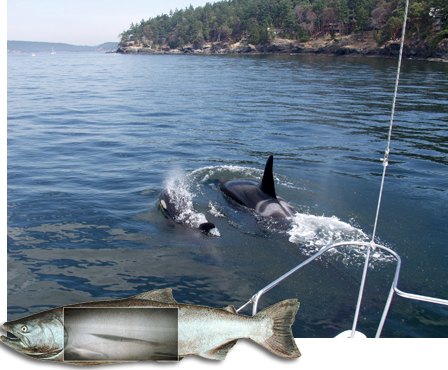forum
library
tutorial
contact

Sounds Like My Favorite Fish
by Phil BerardelliScienceNOW Daily News, November 12, 2008
|
the film forum library tutorial contact |

|
Sounds Like My Favorite Fish
by Phil BerardelliScienceNOW Daily News, November 12, 2008 |
 Some of the killer whales off the coast of Washington state are picky eaters, preferring Chinook salmon even though the coho and sockeye varieties are much more plentiful. Researchers report that the whales seem to be able to tell the three species apart by the sonar echoes bouncing off their swim bladders. The discovery should help efforts to protect these intelligent mammals and maybe someday lead to the design of new devices that could identify individual fish species remotely.
Sorting the three salmon species isn't easy even after you've landed them, but certain pods of Orcinus orca can discriminate between individual fish as they move around the dark and turbulent waters of the southern Puget Sound. Researchers suspected that the whales prefer Chinook salmon because they carry more fat and therefore provide more calories. "The whales get more bang for the bite," says marine ecologist John Horne of the University of Washington, Seattle. Horne and colleagues understood generally how the whales found their prey: by reading the echoes from their built-in sonar. But no one knew what acoustic characteristics could help the orcas tell one salmon species from another.
Some of the killer whales off the coast of Washington state are picky eaters, preferring Chinook salmon even though the coho and sockeye varieties are much more plentiful. Researchers report that the whales seem to be able to tell the three species apart by the sonar echoes bouncing off their swim bladders. The discovery should help efforts to protect these intelligent mammals and maybe someday lead to the design of new devices that could identify individual fish species remotely.
Sorting the three salmon species isn't easy even after you've landed them, but certain pods of Orcinus orca can discriminate between individual fish as they move around the dark and turbulent waters of the southern Puget Sound. Researchers suspected that the whales prefer Chinook salmon because they carry more fat and therefore provide more calories. "The whales get more bang for the bite," says marine ecologist John Horne of the University of Washington, Seattle. Horne and colleagues understood generally how the whales found their prey: by reading the echoes from their built-in sonar. But no one knew what acoustic characteristics could help the orcas tell one salmon species from another.
So Horne and colleagues bounced digital replicas of the orcas' clicks off live but immobilized specimens of the three salmon species. Their analysis showed that one characteristic--the structure of the echoing sound waves--differed among the coho, sockeye, and Chinook salmon. As bioacoustician and team member Whitlow Au of the University of Hawaii, Honolulu, reported Tuesday at a meeting of the Acoustical Society of America in Miami, Florida, further study showed that the salmon swim bladders vary considerably in size. The Chinook's bladder is only half as large as those of the other two species. That's important, Horne explains, because the swim bladder is responsible for 90% of the reflected sound energy. "It acts almost like a wall," he says. The team concluded that the echoes from the three species differ enough for orcas to detect and discriminate single Chinook at distances of 100 meters or more. The remaining question, Horne says, is how killer whales process these signals. But even if that remains a mystery, the research could lead to the development of sonar devices or analytical techniques that could classify and identify individual fish species, making it easier to take a population census. "That would be the Holy Grail of fisheries acoustics," he says.
The findings are important, says killer whale biologist John Ford of the Pacific Biological Station in Nanaimo, Canada. "The question we've been stewing on for some time is how the whales differentiate among the salmon," he says. The research answers that question, but it poses another issue, Ford explains. The whales have evolved to feed on the Chinook, whose population is in decline, so it is essential that their access remain unrestricted. These findings mean we need to determine how much "underwater vessel noise might interfere with their ability to detect salmon in their critical habitats," he says.
learn more on topics covered in the film
see the video
read the script
learn the songs
discussion forum
